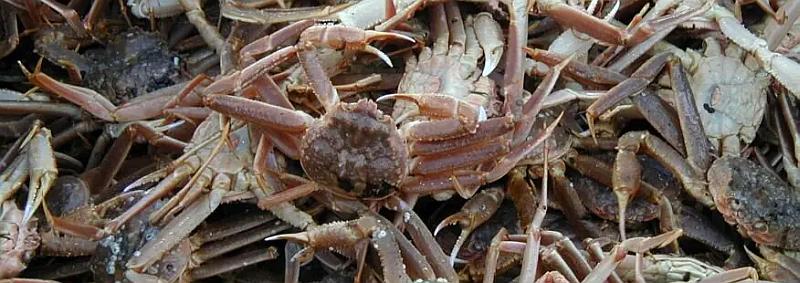 For the first time, the Alaska Department of Fish and Game has canceled the upcoming winter snow crab season in the Bering Sea following the disappearance of 90 percent of snow crabs last season. The state is also continuing a ban on catching king crabs in the Bristol Bay for a second consecutive year.
For the first time, the Alaska Department of Fish and Game has canceled the upcoming winter snow crab season in the Bering Sea following the disappearance of 90 percent of snow crabs last season. The state is also continuing a ban on catching king crabs in the Bristol Bay for a second consecutive year.
Alaska’s crab fishing industry is worth more than $200 million, according to a report by the Alaska Seafood Marketing Institute, which promotes seafood. The state supplies 6 percent of the world’s king, snow, tanner, and Dungeness crabs, per the institute.
“We’re still trying to figure it out, but certainly there’s very clear signs of the role of climate change in the collapse,” Michael Litzow, shellfish assessment program manager at the National Oceanic and Atmospheric Administration, said, as reported by Bloomberg. NOAA runs an annual survey of Bering Sea snow crab numbers, but it was the Alaska Department of Fish and Game that canceled the Bering snow crab fishing season on Oct. 10.
“These are truly unprecedented and troubling times for Alaska’s iconic crab fisheries,” Jamie Goen, executive director of the Alaska Bering Sea Crabbers, a trade association that says it represents some 70 percent of local crab harvesters, said in a statement. “Second and third-generation crab-fishing families will go out of business due to the lack of meaningful protections by decision-makers to help crab stocks recover.”
Alaska’s Governor Mike Dunleavy wrote to Secretary of the U.S. Department of Commerce, Gina Raimondo, requesting she declares a fishery disaster determination for the 2022/23 Bristol Bay red king crab and Bering Sea snow crab fisheries. Additionally, Governor Dunleavy requested that the secretary expedites a disaster determination for the 2021/22 Bristol Bay red king crab fishery.
What caused the crab population collapse?
The first thing to understand is that it wasn’t a sudden decline, Erin Fedewa, a fisheries research biologist for the National Oceanic and Atmospheric Administration (NOAA) told the Guardian. “The snow crab story has to start back in 2018,” she says. That year, an unusually high snow crab population count coincided with one of the warmest years, and periods of lowest sea ice extent, on record in the Bering Sea.
This event – which was fallout from the north-east Pacific marine heatwave – was an anomaly attributable to the climate crisis, and associated with die-offs in a number of species including seals and seabirds.
In 2019 (another year of record-breaking temperatures), NOAA’s annual trawl survey in the east Bering Sea – designed to give fisheries managers and fishers an indication of the health of crab stocks – revealed steep declines in the numbers of juvenile crabs.
But by 2021, the survey revealed that crabs of all ages, not just juveniles, had decreased, Fedewa says. “I just remember being out on the boat and knowing that something was wrong, because at stations that we normally sample several thousand snow crabs, we were catching maybe a couple of hundred.” The situation continued into 2022, when the survey revealed that the snow crab population had dropped from an estimated 11.7 billion in 2018, to 1.9 billion.
